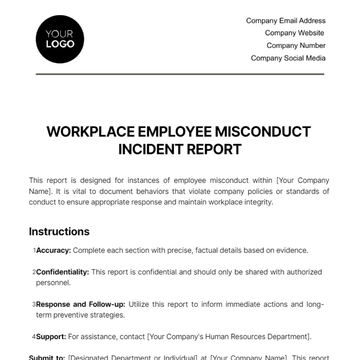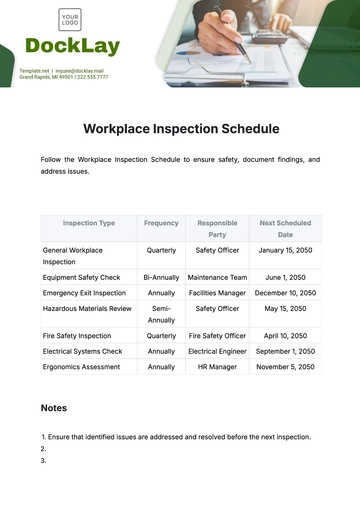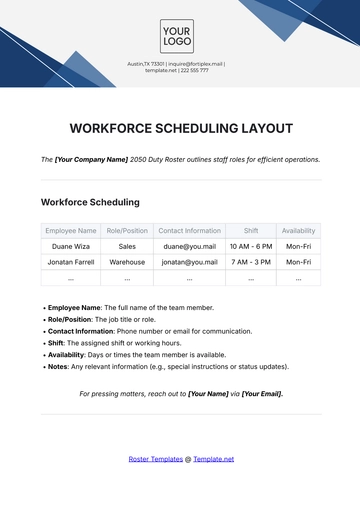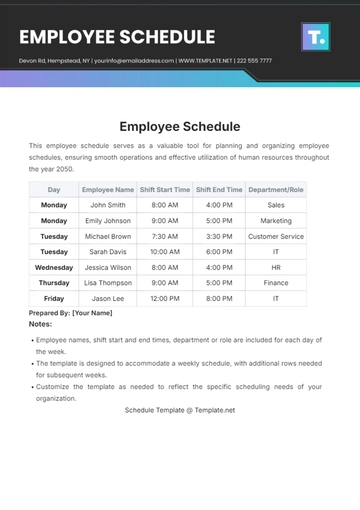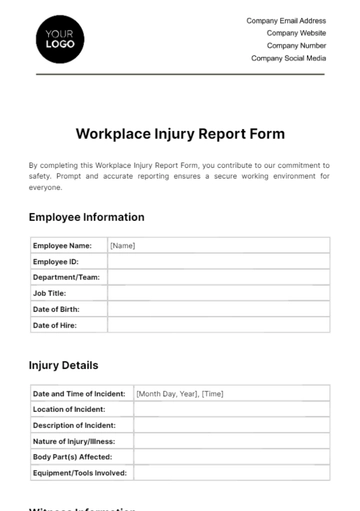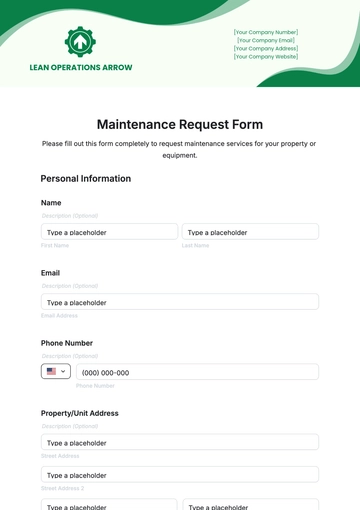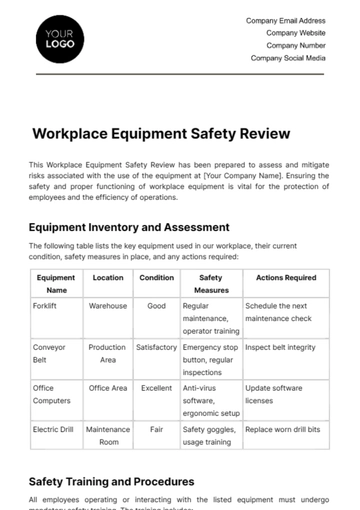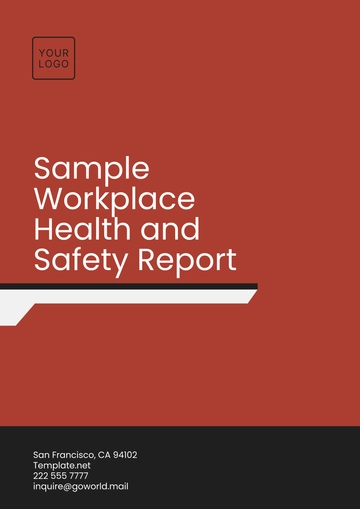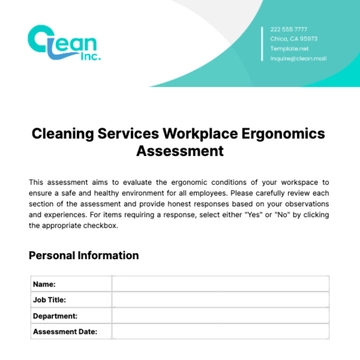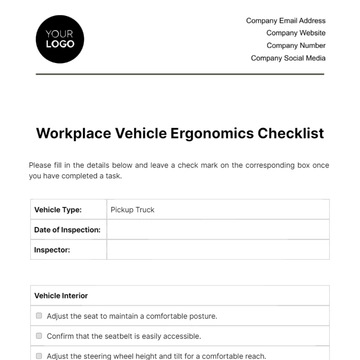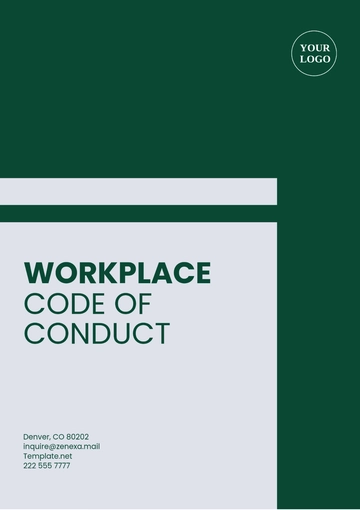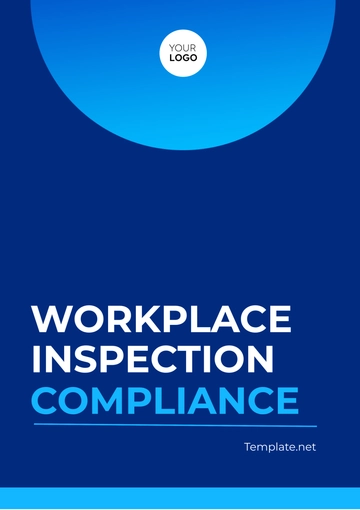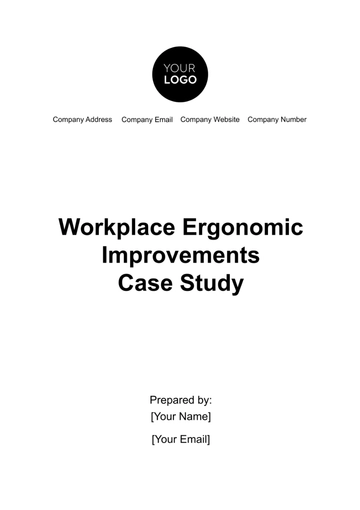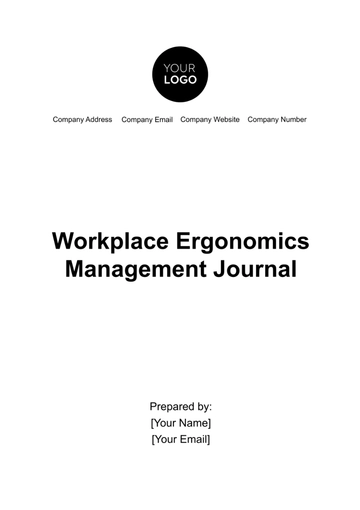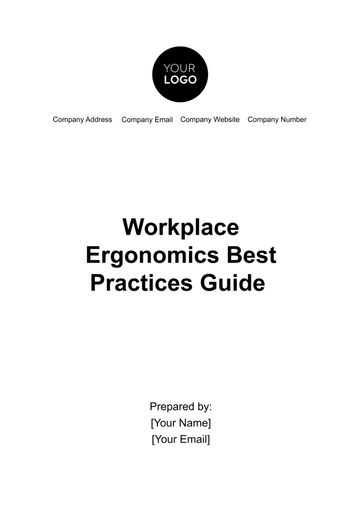Free Workplace Ergonomics Management Journal
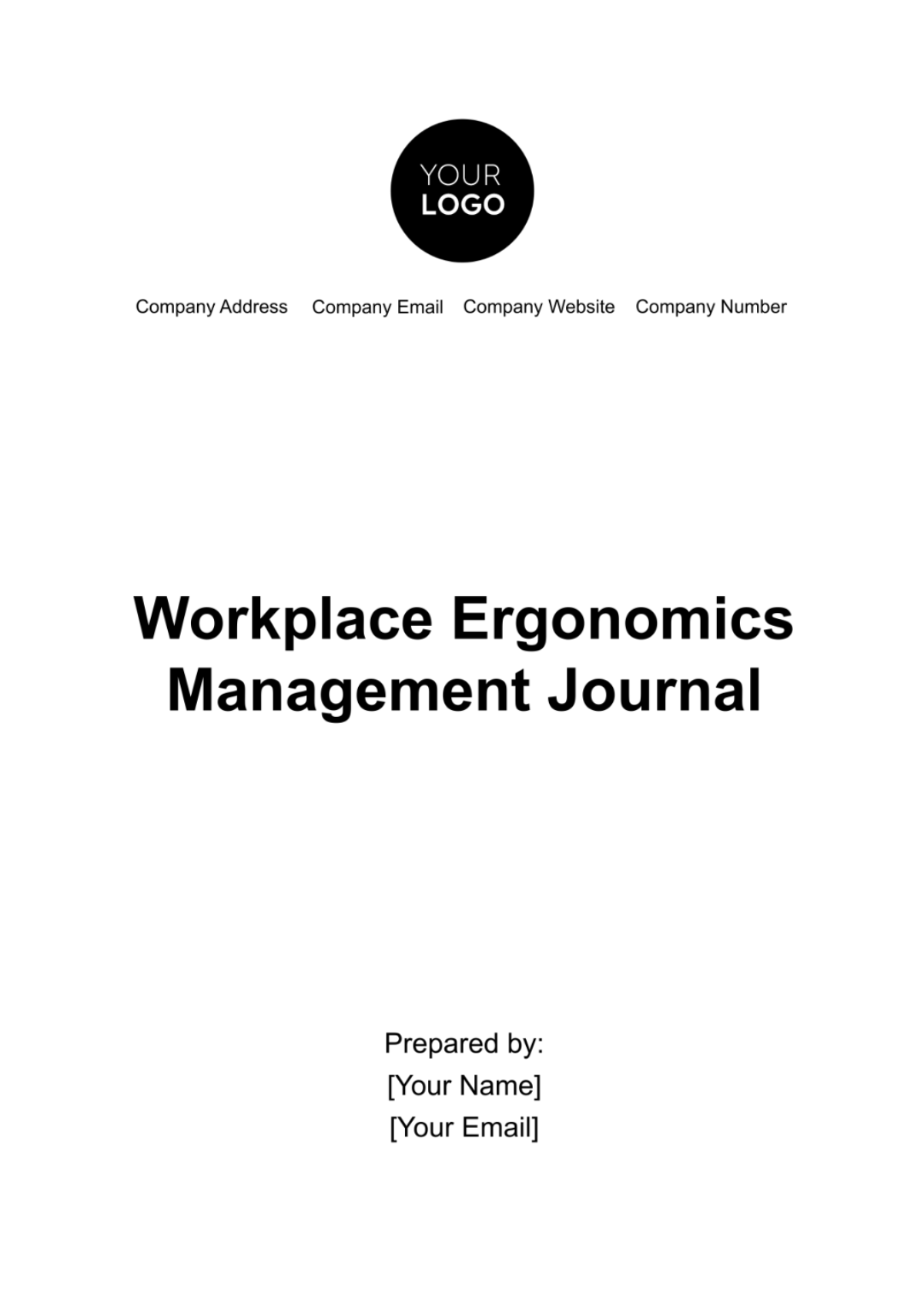
Introduction |
Purpose
The purpose of this Workplace Ergonomics Management Journal is to systematically document, analyze, and guide the ergonomic practices within our workplace. This journal serves as a comprehensive record, capturing our ongoing efforts to enhance the ergonomic environment, ensuring the health, safety, and productivity of our employees. It is a tool for continuous learning, adaptation, and improvement in our ergonomic strategies.
Definition
Workplace ergonomics is the science of designing the workplace to fit the needs of the worker, aiming to optimize human well-being and overall system performance. It encompasses everything from the arrangement of physical equipment to the organization of work processes. Effective ergonomics reduces the risk of injury, improves worker comfort and engagement, and can significantly enhance productivity. In this journal, we will detail our journey towards creating an ergonomic workplace, documenting our assessments, improvements, training, and the overall impact of these initiatives. This continuous recording and analysis are vital for maintaining an adaptable and proactive approach to workplace ergonomics.
Policy Statement
Our organization is committed to providing a safe and healthy work environment for all employees. Recognizing the critical importance of ergonomics in achieving this goal, it is our policy to integrate ergonomic principles into all aspects of our workplace. This involves designing and arranging workstations, tools, and processes in a way that matches the capabilities and limits of our workforce, thereby minimizing ergonomic risks such as musculoskeletal disorders. We are dedicated to continuously identifying, evaluating, and mitigating ergonomic hazards, ensuring that every employee can perform their duties in a comfortable and injury-free environment.
Goals
Establish a Culture of Ergonomic Awareness: Over the next two years, cultivate a workplace culture that recognizes the importance of ergonomics and encourages proactive ergonomic practices among all employees.
Continuous Improvement and Adaptation: Implement a sustained program of regular ergonomic assessments and adjustments, adapting to new technologies, work practices, and employee feedback.
Achieve Significant Reduction in Work-Related Musculoskeletal Disorders: Through ongoing ergonomic interventions and employee education, aim to reduce the incidence of ergonomic-related injuries by 50% within the next five years.
Ergonomic Risk Assessment Record |
This section documents the detailed records of ergonomic risk assessments conducted within our workplace. These assessments are crucial for identifying potential ergonomic hazards and formulating strategies to mitigate them, ensuring a safer and more comfortable work environment.
Date of Assessment | Area Assessed | Summary of Findings |
01/15/2083 | Office Workstations | High incidence of improper seating posture |
02/20/2083 | Production Line | Repetitive motion tasks leading to strain |
04/10/2083 | Warehouse | Manual lifting practices causing lower back stress |
06/06/2083 | CS Desks | Inadequate monitor heights, neck strain |
08/25/2083 | Meeting Rooms | Prolonged sitting without adequate support |
10/14/2083 | Break Room Areas | Insufficient ergonomic seating |
11/29/2083 | Reception Area | Extended standing periods |
01/10/2084 | IT Department | Poor keyboard and mouse ergonomics |
03/03/2084 | Engg Workstations | Inadequate desk space |
Implementation Log |
This section provides a chronological record of the actions taken to address the ergonomic issues identified in our previous assessments. It serves as a dynamic log, tracking the progress of our ergonomic improvement projects and providing updates on their current status.
Date of Action | Area Addressed | Action Taken | Current Status |
02/01/2083 | Office Workstations | Introduction of ergonomic chairs with lumbar support | Completed |
03/05/2083 | Production Line | Implementation of ergonomic tools for repetitive tasks | In progress |
05/10/2083 | Warehouse Operations | Training in safe lifting techniques and equipment use | Completed |
07/20/2083 | Customer Service Desks | Adjusting monitor heights and introducing screen filters | Completed |
09/15/2083 | Meeting Rooms | Replacing chairs with ergonomic seating options | In progress |
12/01/2083 | Break Room Areas | Upgrading furniture to include ergonomic options | Completed |
02/10/2084 | Reception Area | Installation of anti-fatigue mats for standing areas | Completed |
04/15/2084 | IT Department | Upgrading keyboards and mice to ergonomic models | In progress (06/2084) |
Training and Education Records |
This section catalogs the various training and education sessions conducted to enhance ergonomic awareness and practices among our employees. It serves as a record of the schedules, content, attendance, and feedback for these sessions, highlighting our commitment to continuous ergonomic learning and improvement.
Schedule | Content | Attendance | Feedback |
03/10/2083 | Basics of Workplace Ergonomics | 45 | Very positive; requests for more hands-on examples |
04/20/2083 | Proper Use of Ergonomic Chairs and Workstations | 50 | Highly appreciated for practical tips |
06/10/2083 | Ergonomics in Manual Handling and Warehouse Operations | 30 | Positive; more visual aids suggested |
07/25/2083 | Eye and Neck Care in Screen-Based Work Environments | 55 | Extremely helpful; increased awareness noted |
09/05/2083 | Stress Management and Ergonomic Practices in Office Settings | 60 | Very engaging; requests for follow-up sessions |
10/10/2083 | Ergonomics for Outdoor Workspaces | 25 | Good; additional content on outdoor equipment requested |
01/20/2084 | Advanced Ergonomics and Workspace Customization | 40 | Excellent; participants enjoyed the interactive aspect |
Employee Feedback and Suggestions |
This section reflects the valuable insights and perspectives gathered from our employees regarding the ergonomic improvements in our workplace. It presents a summary of key themes identified from their feedback and suggestions, demonstrating how employee involvement shapes our ergonomic strategies.
Feedback Theme | Number of Employees Concerned |
Comfort of Seating Arrangements | 120 |
Adequacy of Workstation Space | 95 |
Effectiveness of Ergonomic Tools | 75 |
Clarity of Ergonomic Training | 85 |
Accessibility of Ergonomic Resources | 60 |
Quality of Lighting and Acoustics | 80 |
Ergonomics in Shared Spaces | 70 |
Flexibility of Work Arrangements | 100 |
Responsiveness to Ergonomic Feedback | 65 |
Overall Satisfaction | 110 |
Incident Reports |
This section meticulously records and analyzes incidents or injuries related to ergonomics in our workplace. It serves as a critical tool for identifying patterns, implementing corrective actions, and preventing future occurrences.
Date of Incident | Incident | Analysis | Follow-Up Actions |
03/15/2083 | Wrist strain from repetitive mouse use | Poor equipment ergonomics | Introduced ergonomic mice and keyboards; conducted training on proper use |
04/22/2083 | Back pain due to prolonged sitting | Inadequate chair support | Replaced chairs with ergonomic models; provided training on proper seating posture |
06/30/2083 | Neck strain from improper monitor height | Monitors not at eye level | Installed adjustable monitor stands; educated employees on ideal monitor positioning |
08/10/2083 | Knee problems from standing at reception | Long standing periods without support | Implemented anti-fatigue mats; introduced rotation schedule for standing and sitting |
10/05/2083 | Shoulder discomfort in warehouse staff | Manual lifting techniques | Conducted manual handling training; introduced lifting aids and equipment |
12/15/2083 | Eye fatigue from screen glare | Inadequate screen positioning and lighting | Installed anti-glare screen filters; adjusted office lighting |
Performance Metrics and Evaluation |
This section focuses on the key performance indicators (KPIs) used to measure the effectiveness of our ergonomic interventions in the workplace. It provides a comparison between current metrics and target goals, alongside periodic evaluation reports that gauge the success of our ergonomic strategies.
KPIs | Current | Target | Evaluation Reports on Effectiveness |
Reduction in Ergonomic-Related Injuries | 20% reduction | 50% reduction | Initial interventions have led to a significant decrease in reported injuries, indicating a positive impact. Further measures are being implemented to reach the target. |
Employee Satisfaction with Ergonomic Setup | 65% Satisfaction | 90% Satisfaction | Surveys show improved satisfaction post-implementation of ergonomic chairs and workstations. Ongoing efforts to enhance other areas for higher satisfaction rates. |
Ergonomic Training Participation Rate | 70% participation | 100% participation | High engagement in initial sessions. Planning additional sessions and formats to increase participation. |
Compliance with Ergonomic Practices | 60% compliance | 85% compliance | Compliance improving with regular training and reminders. Introducing more interactive and frequent training sessions to reach the target. |
Conclusion and Future Plans |
As we reach the conclusion of this Workplace Ergonomics Management Journal, it is evident that our efforts towards improving workplace ergonomics have made a significant impact. The journey documented within these pages—from risk assessments and implementation of ergonomic solutions to training, feedback, and performance evaluations—highlights our deep commitment to the health, safety, and well-being of our employees.
The progress we have made is encouraging, but our journey towards optimal workplace ergonomics is ongoing. The insights gathered through this process have not only helped in addressing immediate ergonomic concerns but have also laid a foundation for future initiatives.
Future Plans
Continued Monitoring and Assessment: We will maintain a regime of regular ergonomic assessments and reviews, ensuring that our workplace adapts to the evolving needs of our employees and the latest in ergonomic research and technology.
Expansion of Training Programs: Building on the success of our initial training sessions, we plan to introduce more comprehensive and diverse ergonomic training programs, covering a broader range of topics and catering to different learning styles.
Enhanced Employee Engagement: We aim to deepen employee involvement in our ergonomic initiatives, encouraging more feedback and participation in the decision-making process to ensure that our strategies are truly representative of their needs.
Integration of Technological Advancements: As new ergonomic tools and technologies emerge, we plan to integrate these advancements into our workplace, continually enhancing the ergonomic quality of our work environment.
Setting New Performance Targets: Based on the evaluations and feedback, we will revise and set new performance metrics, pushing forward towards higher standards in workplace ergonomics.
- 100% Customizable, free editor
- Access 1 Million+ Templates, photo’s & graphics
- Download or share as a template
- Click and replace photos, graphics, text, backgrounds
- Resize, crop, AI write & more
- Access advanced editor
Discover the ultimate solution for ergonomic management with the Workplace Ergonomics Management Journal Template from Template.net. This editable and customizable journal empowers you to track, analyze, and improve workplace ergonomics effortlessly. Seamlessly editable in our Ai Editor Tool, it offers unparalleled flexibility to tailor your journal to perfection. Redefine workplace comfort today!
